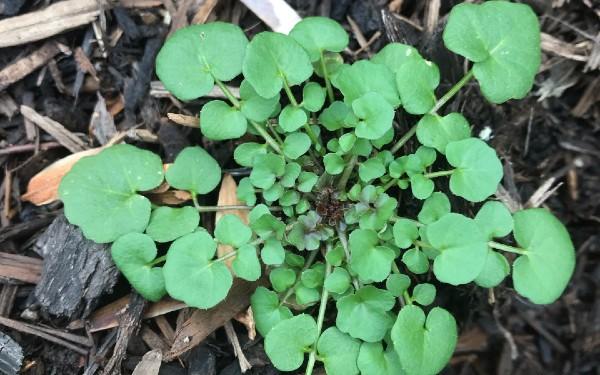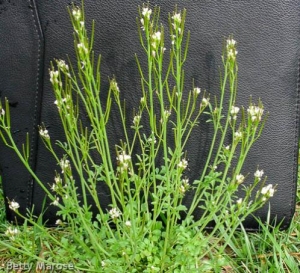Where Did THAT Come From?

Hairy Bittercress
By Joyce Giuliani, Fairfax Master Gardener
This month, as you celebrate the return of your early spring garden, you may encounter a weedy, uninvited guest: hairy bittercress. A member of the mustard family, hairy bittercress (Cardamine hirsuta), is also known as lambscress, springcress, flickweed and shotweed. No matter what you call it, though, it is usually not a welcome sight in lawns and gardens.
What to look for
Hairy bittercress is a winter annual, emerging as a basal rosette with rounded leaves. The “hairy” attribute can be found on the lower leaves of the young plant. Two or four pairs of alternating round leaflets occur along a stem. A reddish-purple stalk emerges near the base, becoming greener as it grows up to 12 inches tall. Over a three-week period, small, white flowers appear on the stalk, followed by an-inch-long, cigar-shaped seedpod. When wind gusts or you or another creature disturb the plant, the pod erupts in a fireworks display. It shoots hundreds of seeds as far as 10 feet from the parent plant in hopes of preserving its kind in your yard (hence, the alternate name, shotweed).
How did it get here?

Hairy bittercress in full bloom
Native to Europe and Western Asia, hairy bittercress has made itself at home in much of the United States. It is very adept at growing in any disturbed soil, especially if a cool, moist environment is present. Thin, shady lawns are prime territory. It is not picky, though. A crack in a sidewalk or gravel path is a fine place for seeds to sprout.
If left unchecked, hairy bittercress can take over lawns and gardens because of its dynamic ability to spread seed. It can also settle in the microclimates of greenhouses and in bedding plant containers, so carefully inspect any planting material you are introducing to your garden.
Here to stay
Its uncanny knack for seed production gives hairy bittercress a fighting chance to be part of your garden now and in the future. There are ways, however, to rein it in. Because it is a winter annual, its seed germinates in the fall, which is when you should treat it — prior to germination — with a pre-emergent weed killer. The Virginia Cooperative Extension’s Pest Management Guide suggests appropriate broadleaf herbicides for use in ornamental beds and lawns for both pre- and post-emergence. For an organic approach, you can remove plants by hand before they flower and go to seed. In ornamental beds, apply woody mulch to discourage seeds from sprouting there. A healthy, vigorous lawn is less likely to allow hairy bittercress seeds to germinate. An infestation indicates the homeowner should work toward a healthier turf.
To be fair, hairy bittercress is not all bad. In fact, some people regard it as a wildflower, rather than a weed. It is edible, and its leaves have a peppery flavor not unlike arugula or watercress. If you are so inclined, you can find recipes online for using it in salads, pesto and risotto. In addition, some butterflies, such as the falcate orange-tip, delight in hairy bittercress at a time when other flowers are just beginning to bloom. As spring moves to summer, most hairy bittercress plants will be gone from sight — but not before leaving seeds behind for the following fall.
So, as the snow melts and your garden emerges, you can rejoice a bit when you see hairy bittercress. After all, it is a sign of spring. Just to be sure to pull up those rosettes before the seeds fly.
References
• Home Turf Broadleaf Weeds, Fairfax County Master Gardeners
• Weed of the Week – Hairy Bittercress, Amy Stone, The Ohio State University
• Biology and Management of Hairy Bittercress (Cardamine hirsuta) in Ornamental Crop Production,
University of Florida, Publication #ENH1250
• Bittercress, Hairy, TurfFiles Centers, North Carolina State Extension
… updated 2024